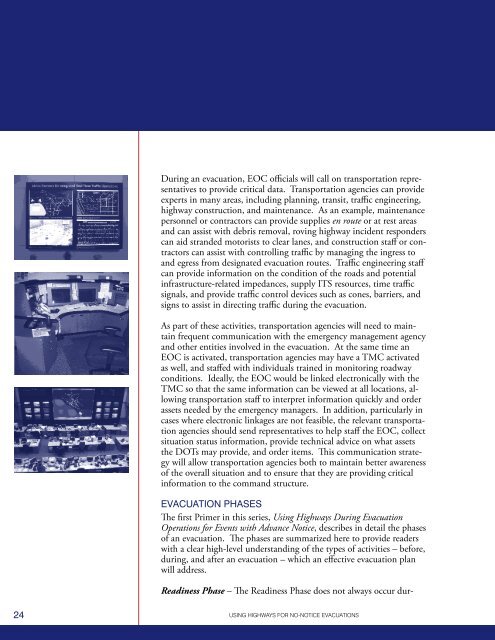using highways for no-notice evacuations - FHWA Operations - U.S. ...
using highways for no-notice evacuations - FHWA Operations - U.S. ...
using highways for no-notice evacuations - FHWA Operations - U.S. ...
Create successful ePaper yourself
Turn your PDF publications into a flip-book with our unique Google optimized e-Paper software.
During an evacuation, EOC officials will call on transportation representativesto provide critical data. Transportation agencies can provideexperts in many areas, including planning, transit, traffic engineering,highway construction, and maintenance. As an example, maintenancepersonnel or contractors can provide supplies en route or at rest areasand can assist with debris removal, roving highway incident responderscan aid stranded motorists to clear lanes, and construction staff or contractorscan assist with controlling traffic by managing the ingress toand egress from designated evacuation routes. Traffic engineering staffcan provide in<strong>for</strong>mation on the condition of the roads and potentialinfrastructure-related impedances, supply ITS resources, time trafficsignals, and provide traffic control devices such as cones, barriers, andsigns to assist in directing traffic during the evacuation.As part of these activities, transportation agencies will need to maintainfrequent communication with the emergency management agencyand other entities involved in the evacuation. At the same time anEOC is activated, transportation agencies may have a TMC activatedas well, and staffed with individuals trained in monitoring roadwayconditions. Ideally, the EOC would be linked electronically with theTMC so that the same in<strong>for</strong>mation can be viewed at all locations, allowingtransportation staff to interpret in<strong>for</strong>mation quickly and orderassets needed by the emergency managers. In addition, particularly incases where electronic linkages are <strong>no</strong>t feasible, the relevant transportationagencies should send representatives to help staff the EOC, collectsituation status in<strong>for</strong>mation, provide technical advice on what assetsthe DOTs may provide, and order items. This communication strategywill allow transportation agencies both to maintain better awarenessof the overall situation and to ensure that they are providing criticalin<strong>for</strong>mation to the command structure.evacuation phasesThe first Primer in this series, Using Highways During Evacuation<strong>Operations</strong> <strong>for</strong> Events with Advance Notice, describes in detail the phasesof an evacuation. The phases are summarized here to provide readerswith a clear high-level understanding of the types of activities – be<strong>for</strong>e,during, and after an evacuation – which an effective evacuation planwill address.Readiness Phase – The Readiness Phase does <strong>no</strong>t always occur dur-24 USING HIGHWAYS FOR NO-NOTICE EVACUATIONS
















